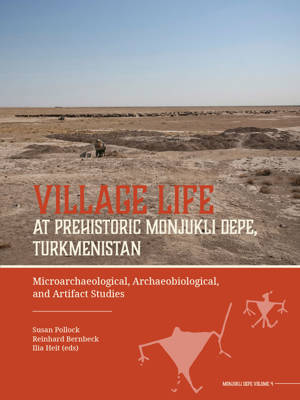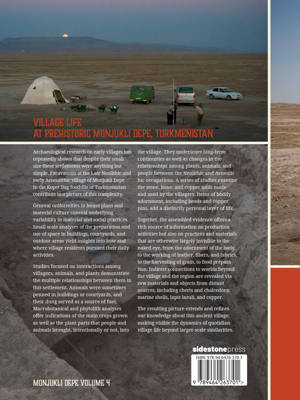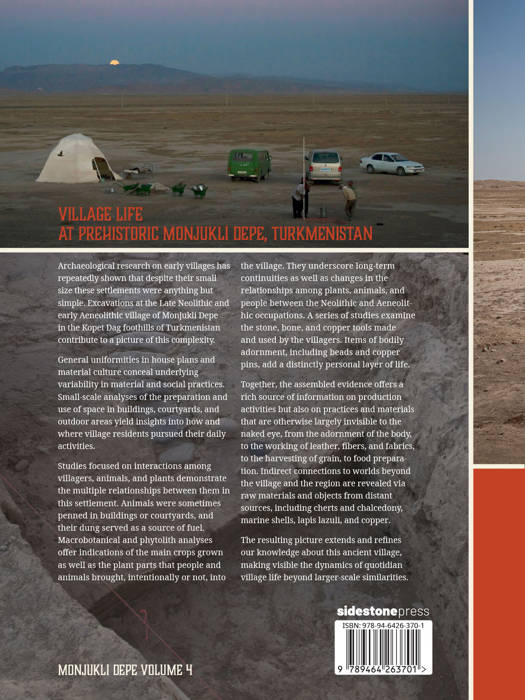
- Afhalen na 1 uur in een winkel met voorraad
- Gratis thuislevering in België vanaf € 30
- Ruim aanbod met 7 miljoen producten
- Afhalen na 1 uur in een winkel met voorraad
- Gratis thuislevering in België vanaf € 30
- Ruim aanbod met 7 miljoen producten
Zoeken


Village Life at Prehistoric Monjukli Depe, Turkmenistan
Microarchaeological, Archaeobiological, and Artifact Studies
Pollock Susan
Hardcover | Engels
€ 254,45
+ 508 punten
Uitvoering
Omschrijving
Archaeological research on early villages has repeatedly shown that despite their small size these settlements were anything but simple. Excavations at the Late Neolithic and early Aeneolithic village of Monjukli Depe in the Kopet Dag foothills of Turkmenistan contribute to a picture of this complexity. General uniformities in house plans and material culture conceal underlying variability in material and social practices. Small-scale analyses of the preparation and use of space in buildings, courtyards, and outdoor areas yield insights into how and where village residents pursued their daily activities. Studies focused on interactions among villagers, animals, and plants demonstrate the multiple relationships between them in this settlement. Animals were sometimes penned in buildings or courtyards, and their dung served as a source of fuel. Macrobotanical and phytolith analyses offer indications of the main crops grown as well as the plant parts that people and animals brought, intentionally or not, into the village. They underscore long-term continuities as well as changes in the relationships among plants, animals, and people between the Neolithic and Aeneolithic occupations. A series of studies examine the stone, bone, and copper tools made and used by the villagers. Items of bodily adornment, including beads and copper pins, add a distinctly personal layer of life.
Together, the assembled evidence offers a rich source of information on production activities but also on practices and materials that are otherwise largely invisible to the naked eye, from the adornment of the body, to the working of leather, fibers, and fabrics, to the harvesting of grain, to food preparation. Indirect connections to worlds beyond the village and the region are revealed via raw materials and objects from distant sources, including cherts and chalcedony, marine shells, lapis lazuli, and copper.
The resulting picture extends and refines our knowledge about this ancient village, making visible the dynamics of quotidian village life beyond larger-scale similarities.
Together, the assembled evidence offers a rich source of information on production activities but also on practices and materials that are otherwise largely invisible to the naked eye, from the adornment of the body, to the working of leather, fibers, and fabrics, to the harvesting of grain, to food preparation. Indirect connections to worlds beyond the village and the region are revealed via raw materials and objects from distant sources, including cherts and chalcedony, marine shells, lapis lazuli, and copper.
The resulting picture extends and refines our knowledge about this ancient village, making visible the dynamics of quotidian village life beyond larger-scale similarities.
Specificaties
Betrokkenen
- Auteur(s):
- Uitgeverij:
Inhoud
- Aantal bladzijden:
- 340
- Taal:
- Engels
Eigenschappen
- Productcode (EAN):
- 9789464263718
- Verschijningsdatum:
- 4/11/2025
- Uitvoering:
- Hardcover
- Formaat:
- Genaaid
- Afmetingen:
- 210 mm x 279 mm

Alleen bij Standaard Boekhandel
+ 508 punten op je klantenkaart van Standaard Boekhandel
Beoordelingen
We publiceren alleen reviews die voldoen aan de voorwaarden voor reviews. Bekijk onze voorwaarden voor reviews.









